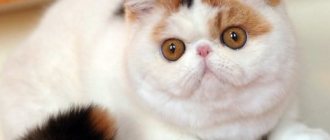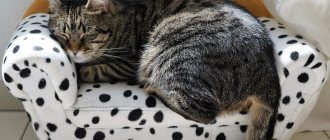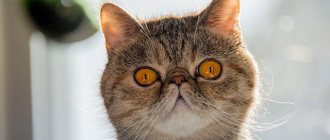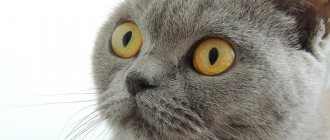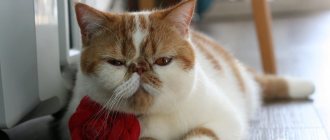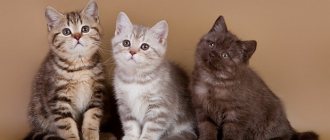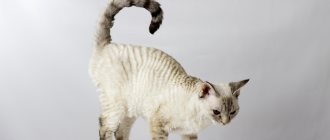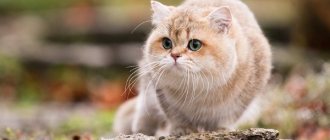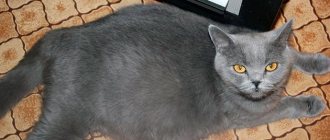The American Shorthair is a beautiful cat with a friendly disposition and a sharp mind. She has come a long way from yard rat catchers to pets and now enjoys well-deserved popularity among experienced and novice felinologists.
To understand who these attractive and slightly lazy animals are suitable for, let’s look at the specifics of the breed.
Brief history of the breed
Presumably the cats that became the ancestors of the American Shorthair were brought to the New World at the beginning of the 17th century by a group of British Protestants.
The cats they brought were forced to adapt to the new climate and changed living conditions. Gradually, the tailed ratcatchers increased in size and acquired thicker, coarser fur.
Until the beginning of the 20th century, cats did not arouse interest among overseas felinologists, but then American breeders seriously began breeding these hardy animals.
In 1904, the CFA registered the Buster Brown, a direct descendant of cats introduced by British colonists. And in the middle of the 20th century, a catalog was published, which included about 50 representatives of the breed known as domestic shorthair.
In 1965, the cats were renamed American and a program for the development and preservation of their purebred was developed.
Sterilization or castration
If breeding is not of interest, then the question arises: is it worth sterilizing the animal? There are special drugs that inhibit the sexual activity of cats. These can be drops, injections or tablets. But not everyone knows that their constant use is undesirable. These medications are designed to temporarily stop active sexual behavior in cats. With constant or frequent use, they can provoke diseases of the genital area. Therefore, if offspring are not planned, it is better to resort to castration or sterilization surgery.
Castration (Latin castratio - castration) is an operation to remove the gonads in animals. After castration, animals are not only incapable of reproducing offspring, but also stop displaying sexual behavior. In males, territorial marking and aggression disappear; in females, signs of estrus disappear due to the inability to produce sex hormones.
Sterilization (Latin sterilis - sterile) is a surgical operation that results in the deprivation of the animal's ability to bear children while maintaining the production of sex hormones. During this operation, the gonads are not removed, but the vas deferens in males or the fallopian tubes in females are ligated, or they are partially removed, which prevents conception. After sterilization, unlike castration, the production of sex hormones and sexual instincts are preserved.
Your veterinarian will help you decide whether to spay or neuter your pet. But both of these procedures are aimed at correcting the animal’s behavior and the inability to produce offspring.
Advantages of sterilization (castration)
Some facts can be confidently considered as an advantage of sterilization (castration):
- Such animals live longer and get sick less often.
- In cats, this operation eliminates uterine diseases and significantly reduces the risk of mammary gland diseases.
- Neutered cats are distinguished by their docile and balanced character.
- In cats, the likelihood of diseases such as prostatitis, hormone-dependent tumors of the testicles and testes is reduced.
- Castration and sterilization operations are well established and are carried out in all clinics. They are safe and painless.
It is best to spay cats between 6 and 9 months of age before their first heat cycle. In this case, the risk of breast tumor formation is minimized.
It is best for a cat to undergo this procedure at 7–9 months. At this time, he is already quite old; puberty has begun, but has not yet completed. You can also operate on an adult cat, but at a young age the animal tolerates the operation more easily. In addition, 15% of adult cats may continue to mark their territory out of habit, although the marks do not have such a strong odor.
Post-operative care
Post-operative care does not require much effort. In cats, stitches are removed on days 8–12, and the cat feels great immediately after emerging from anesthesia.
After the operation, the cat will spend 8–12 days in a bandage, then the stitches will be removed
Possible complications
The correct age of the animal is the key to ensuring that the operation goes without complications. The older the pet, the more difficult it will be for him to endure anesthesia and the procedure itself.
Any castration is carried out under general anesthesia, and anesthesia is always a health risk, although low. Therefore, it is not recommended to operate on animals older than 8 years.
Complications may occur after surgery:
- bleeding;
- development of infection;
- divergence of seams.
Their likelihood is reduced if the surgeon is well qualified.
Neutered cats have an increased risk of developing urolithiasis. If the animal eats dry food, then it should be switched to a line of special products for neutered cats. It is important that the cat drinks enough water. If your pet is fed natural food, then you should limit fish and fatty meat, and monitor the constant availability of clean water.
Interesting Facts
During the existence of American women, a lot of interesting things happened to the breed:
- There is a legend that American shorthair cats were present on all the ships of Christopher Columbus's flotilla during his search for India. The legendary navigator believed that animals would save food supplies from rodents and ordered to take them with him. And this is how the ancestors of American women came to the lands of the Indians. True, this version has no documentary evidence and remains simply a beautiful legend.
- The American Shorthair is the national pride of the United States. The cat is considered the same symbol of the country as apple pie or baseball.
- American Shorthairs helped form several other breeds, including the Exotic, Devon Rex, Snowshoe, Scottish Fold and Bengal.
Munchkin
Munchkins are no different from other cats, except that they cannot jump on very high surfaces.
The history of short-legged cats began in the early 80s. A Louisiana woman picked up a strange short-legged cat that turned out to be heavily pregnant. The cat was named Blackberry. Most kittens born inherit short legs from their mother.
Munchkins have both fans and haters. Some squeal touchingly at the sight of a charming cat with short legs, others contemptuously call munchkins disabled or even freaks. Only one thing can be said for sure: no one remains indifferent to these funny representatives of the feline family. In addition, numerous studies have shown that the gene for short legs is a natural mutation that does not cause any harm to the animal.
By nature, munchkins resemble cheerful, mischievous gnomes. Affectionate and sociable munchkins, despite their not very large size, immediately attract a lot of attention. And their ability to stand on their hind legs, touchingly moving their front legs, will cause a groan of tenderness even from the most callous person in the world.
Based on the Munchkin breed, many daughter breeds were bred:
- kinkalow,
- Dwelf,
- bambino,
- minuet,
- Minskin et al.
Breed description, standards, appearance
The American Shorthair is a harmoniously developed cat whose athletic build corresponds to its purpose as a mousecatcher.
The official breed standard was approved in 1966.
Dimensions and weight
The American is a large cat with well-developed bones, a broad chest and a strong build. Depending on the gender, the weight of representatives of the breed ranges from 5-8 kg.
Anatomical characteristics
A typical American Shorthair cat should fit the following description:
- The head is large with a rounded muzzle, strong jaws, developed cheeks, a pronounced chin and a straight nose.
- The eyes are round and shiny. Widely spaced. The eye color is in harmony with the main coat color. Most often it is copper, yellow or green. White American women are allowed blue irises.
- The ears are medium in size, set wide apart with rounded tips.
- The body is harmoniously built and muscular. The back is level, the shoulders and chest are well developed.
- The limbs are of medium length, straight with round paws. They have parallel posture and heavy muscles.
- The tail is thick at the base, gradually tapering to a rounded tip.
Color and coat type
The American cat has a short, hard-to-the-touch coat, under which is hidden a dense down.
On a note. The density of the American cat's undercoat varies depending on the time of year and the climatic conditions in which the cat lives.
The breed standard provides for more than 60 color options, which are usually divided into smoky, spotted, plain and tabby. The most common colors found in American women are:
- black;
- ginger;
- white;
- cream;
- blue.
On a note. White American women often have heterochromia.
Possible breed defects
Disadvantages of the exterior of American women, in the presence of which the cat does not receive high expert ratings:
- close-set or elongated ears;
- thin or thick tail;
- elongated, stocky body;
- creases on the tail;
- “plush” wool;
- underdeveloped croup.
Defects for which the American Shorthair is subject to disqualification:
- white points;
- deep stop;
- fluffy or long hair;
- goggle-eyed;
- undershot or overshot;
- cryptorchidism.
American females whose coat is colored in the following colors are not allowed for breeding:
- chocolate;
- lilac;
- Burmese;
- Tonkinese;
- cinnamon;
- faun.
Laperm
The name of the breed comes from the English word permanent, which refers to a hairdressing procedure for curling hair.
The breed of Laperm cats is based on generations of street, stray cats, however, oriental features are also visible. In the early 80s, in the state of Oregon, a strange kitten turned out to be in the next litter of a barn cat - long-eared, bald and with stripes on its skin. After a while, Curly (as the kitten was named) began to become covered with soft and wavy fur, which became increasingly thicker. Curley subsequently also became the father of offspring, which inherited his unusual feature. Guests of the farm noticed Curly's kittens and decided to show them to their familiar felinologists. In 1997, the Laperm breed standard was written, and in 2002 it was recognized by TICA.
By nature, the Laperm is the most loving breed of cat. They love everyone: owners, guests, children, other cats and dogs. Just give him free rein, and the laperm will hug and lick everyone in his path. They love to sit in public. For a Laperm to be happy, it needs a large, loving family.
Character and temperament
The American is an easygoing, loving cat, which is not at all characterized by aggressive behavior. She easily tolerates loneliness and quickly adapts to changing conditions. An independent and independent American woman will not bother her owners, persistently demanding attention.
A cat of this breed respects the personal space of others and expects the same in relation to itself.
The American woman has a phlegmatic temperament and is prone to laziness. A cat of this breed is not one of those who will run around the house for hours, ride on curtains and jump on cabinets. Rather, she would prefer to take a quiet nap on a cozy sofa.
Breed and children
Calm and friendly cats get along with kids without any problems. American women are lenient towards childish pranks and tolerate careless treatment.
If cats of this breed get tired of the annoying company of children, they will simply hide high on the closet.
Breed and other animals
American women are able to peacefully coexist with dogs and other medium and large pets. Even if they do not become best friends, they still will not compete for their master’s attention and divide the territory.
Since American females have developed hunting instincts, they cannot be kept together with rodents and ornamental birds.
Characteristic
The main qualities and characteristics of the American Shorthair cat on a 10-point scale:
- family attachment 6/10
- shedding intensity 6/10
- general health 8/10
- playfulness 4/10
- good attitude towards children 8/10
- good attitude towards strangers 8/10
- ease of care 8/10
- intelligence 8/10
- friendliness to other pets 6/10
How to choose the right kitten
It is better to purchase an American female from a specialized nursery that breeds this breed. Before purchasing, be sure to read the documents for the brood and inspect the living conditions of the animals. If everything is in order with cleanliness and papers, you can safely proceed to choosing a baby.
A healthy kitten of this breed has shiny fur, a soft belly, clear eyes and an excellent appetite. The little American girl's skin is clean, without redness or scratching. He shows interest in everything that happens and is not afraid of strangers.
Kitten care
Conscientious breeders transfer American females to new homes no earlier than they are 12-16 weeks old. By this age, kittens are already quite independent. They know how to eat, are litter box trained and know the scratching post. Of course, they will need some time to adapt to the changed conditions, but this process goes very quickly.
In order for the tailed pet to feel comfortable in its new home, at first it is given more attention and fed what the breeder gave it. And to facilitate the process of caring for an American Shorthair kitten, they purchase in advance:
- bowls for water and food;
- tray and filler;
- toys;
- carrying bag;
- bed or house;
- scratching post;
- grooming tools;
- hygienic cosmetics.
Important! American Shorthair kittens are very curious and try to play with everything that comes their way. Therefore, for their safety, wires are well secured in the house and all small objects are hidden.
Care and maintenance
Since the American has a dense undercoat, she can live in the yard during the warm season. In general, this cat breed is quite unpretentious; caring for it comes down to basic hygiene and proper feeding.
Hygiene procedures
In order for the cat to look neat, it is provided with appropriate care:
- The American Shorthair's eyes and ears are regularly wiped with a damp cloth or cotton pad and inspected for any purulent or foul-smelling discharge.
- Brush your cat's teeth weekly with a silicone brush and a small amount of non-foaming toothpaste. This procedure helps prevent the appearance of plaque and stone. That’s why American women are taught it from an early age.
- A cat's claws wear down naturally, but if necessary, they can be carefully trimmed with a nail clipper. They do this as carefully as possible so as not to damage the blood vessels of the American woman.
Grooming
Cats of this breed are quite clean and do not like water. That’s why American women are bathed no more than 3-4 times a year. Bath procedures are carried out in a warm room where there are no drafts.
The cat's fur is moistened with warm water, thoroughly lathered with a special shampoo and rinsed. The bathed pet is dried with a towel and, if necessary, dried with a hairdryer.
Brush the American Shorthair using a rubber brush or a special glove with silicone growths. In normal times, this is done once a week, during seasonal molting - daily.
Tray
The American Shorthair is large in size and also loves to dig. Therefore, a spacious tray with high sides is selected for it. Any filler can be used. The main thing is that it absorbs moisture well.
On a note. In order not to spend money on filler, you can buy a tray with a mesh for the American woman. But you will have to wash it several times a day.
Purchasing a kitten
It is necessary to select and purchase a kitten only in a nursery that specializes in breeding this breed.
You should not trust the low price of kittens sold without documents on ad sites, since it is almost impossible to distinguish purebred animals from domestic ones.
A competent breeder will always tell you about the characteristics of the breed, show documents for the litter and the pedigrees of the parents. Good owners never sell kittens that are still being fed by their mother cat. You can only pick up those babies who have learned to feed themselves.
The ideal age for a kitten is three months. The grown-up baby no longer needs breast milk, has balanced mental and physical health and is vaccinated against dangerous infectious diseases.
Particular attention should be paid to veterinary certificates and vaccinations of the kitten. This helps to avoid purchasing a sick animal.
Kittens must be active and look healthy and well-groomed.
The kitten must be active and have a healthy and well-groomed appearance. He should be moderately well-fed and have a shiny, silky coat. The baby's eyes and ears should be free of pathological discharge, and the area under the tail should be clean and dry.
The price of an American Shorthair kitten starts from 20 thousand rubles and depends on gender, color and other factors. If in the future the pet is expected to participate in exhibitions and further breeding, the cost of the kitten increases to 50 thousand rubles. and more. You can find options costing 8–10 thousand rubles, but these will be kittens from a casual relationship and without any guarantees.
Feeding the cat
The American Shorthair has an excellent appetite and eats both industrial and natural food with equal pleasure. The main thing is to choose one type of food and not mix them. It is advisable to feed your cat at the same time, making sure that she does not have 24/7 access to food.
Complete diet
When feeding American Shorthair, preference is given to super premium or premium products. It contains no questionable additives and contains the entire range of nutrients necessary for the proper development of the animal.
It is best to feed the American Shorthair the following brands:
- Arden Grange;
- Farmina;
- Hills;
- RoyalCanin.
With a natural type of nutrition, the cat's diet is composed so that fresh, lean meat predominates in it. Also, the American Shorthair must be given:
- porridge cooked in water;
- eggs;
- offal;
- vegetables;
- lean sea fish;
- dairy products.
On a note. American shorthair vegetables are given in boiled and chopped form. Otherwise, the cat will simply leave them in the bowl.
It is strictly forbidden to feed animals of this breed with sweets, pork, river fish and any leftovers from the master's table.
Feeding frequency
American Shorthair kittens eat more often than adult representatives of the breed. Therefore, the feeding regimen depends on the age of the pet:
- up to 6 months – 4-5 times a day;
- 6-12 months – 3 times a day;
- from 12 months – 2 times a day.
Vitamins and mineral supplements
With a natural diet, an American shorthair cat may not receive enough microelements. Therefore, representatives of the breed are given vitamin and mineral complexes twice a year.
When selecting such supplements, the individual characteristics of a particular American woman are taken into account and are guided by the recommendations of a veterinarian.
Coat color
The American Shorthair cat comes in more than 80 colors. You can find any desired color - single-color, three-color, striped, etc.
Plain
Let's say red, otherwise they call it red. A solid blue American Shorthair cat is shown in the photo. There are cream, black and white shades. Pure colors do not appear so often, so they are highly valued.
Tabby
Often tortoiseshell tabby, brown tabby (pictured), etc. appear in the litter. Tabby colors include clear stripes, narrow short stripes, wide more diffuse stripes, or only markings on the forehead.
In English, tabby means “motley” or “striped.” The tabby color is considered the oldest. It appeared naturally as a method of camouflage for wild cats. The tabby's fur allowed predators to hide in the bushes and then attack their prey unnoticed.
Marble
The American Shorthair cat is famous for its silver tabby color (pictured). This is the color you can see in the Whiskas advertisement. There are clearly visible stripes here that resemble marble stains. They are more chaotic than the parallel brindles of other breeds.
Spotted (tri-color)
The photographs clearly show 3 main shades. Sometimes two mixed shades are found, but more often spotted cats are born tri-colored.
Interesting!
Often tricolor cats are females.
Education and physical activity
American Shorthair cats are very smart, but very stubborn and independent animals. Therefore, representatives of the breed can be taught to follow commands or do various tricks. However, this will require patience and perseverance.
In order for the American Smoothhair to have the opportunity to run, it is regularly taken for walks. Cat houses are equipped with a play complex with numerous shelves and ladders.
Somalia
The exquisite beauty of the Somali cat is combined with its extraordinary character.
Somalia is ice and fire in one bottle. Her striking, almost unbearable beauty is skillfully intertwined with an active and playful, but at the same time silent and delicate character. Somalia is the star of all shows and a wonderful companion pet.
In terms of its breed qualities, the Somali is a semi-longhaired version of the Abyssinian cat. As in the case of the Balinese, longhaired Abyssinians were born regularly, but were considered a breeding marriage and were mercilessly culled until the American Mary Mayling showed a longhaired Abyssinian at an exhibition in Canada in 1963. The Somali has a similar standard to the Abyssinians, except for the length of the coat.
Vaccinations and antiparasitic treatment
American Shorthair cats often die from viral diseases. To prevent the premature death of a pet, it is regularly vaccinated with a complex drug that produces immunity:
- to calcivirus;
- rhinotracheitis;
- panleukopenia.
The first vaccination is given to a kitten at the age of 7-8 weeks. At 11-12 weeks, an American woman is vaccinated against the same diseases and against rabies. Subsequently, the cat is vaccinated once a year.
To protect the American woman from diseases carried by fleas and helminths, she is regularly treated for parasites:
- Antihelminthic medications are given to a cat of this breed once every six months, repeated every 10-14 days.
- To protect against fleas, use special shampoos, drops or collars.
Selkirk rex
This plush, curly bear was bred in Montana in the late 80s. The history of the Selkirk is similar to the stories of his curly-haired, “Rex” comrades: Cornish Rex, Devon Rex, Ural Rex. One day a curly-haired kitten was born, and he was so cute that they decided to fix the mutation. In 1992, the breed was officially recognized by TICA. During the formation of the breed, Persian, British, and exotic cats were involved - from them the Selkirk inherited a squat, powerful body, thick strong legs, a short neck, charming full cheeks and round saucer eyes with a “sweet” expression.
Pros and cons of the breed
Like any other cat breed, American Shorthairs have both advantages and disadvantages.
| pros | Minuses |
| Unpretentiousness | Laziness |
| Lack of aggression | Tendency to solitude |
| Attractive exterior | Predisposition to obesity |
The American Shorthair is a beautiful cat with high intelligence and an accommodating, friendly disposition. Sociability, combined with pronounced hunting instincts and the talent of a rat catcher, make the breed popular not only among city dwellers, but also among rural residents.
Photo of American Shorthair
Read here Savannah - description of the breed, character and price of the cat. Expert advice on home care (85 photos)
Help the site, share with friends 

